Abstract
Tryptase, a neutral protease of human mast cells, is a potentially important indicator of mast cell involvement in various clinical conditions. The current study examined the time course of appearance and disappearance of tryptase in the circulation after an anaphylactic event and the stability of both endogenous and exogenous tryptase in terms of freeze-thawing and temperature. The peak level of tryptase after an experimentally induced systemic anaphylactic reaction occurred 1-2 h after the initiating bee sting in each of three subjects, in contrast to histamine levels which peaked at 5-10 min. In some cases elevated levels of tryptase may not be detected during the initial 15-30 min. Tryptase levels then declined under apparent first order kinetics with a t1/2 of approximately 2h. Similar disappearance kinetics were observed for two subjects presenting in the emergency room with immediate type reactions, one with severe asthma after indomethacin ingestion, the other with systemic anaphylaxis after a bee sting. Histamine levels declined rapidly and were back to baseline by 15-60 min. Measured levels of tryptase in serum or plasma were not diminished by up to four freeze-thaw cycles. Incubation of serum samples taken from subjects with elevated levels of tryptase at 22 and 37 degrees C indicated that greater than 50% of endogenous tryptase was still detected after 4 d. Purified tryptase added to serum or plasma and incubated as above was less stable: approximately 50% of exogenous tryptase in serum and approximately 15% in plasma was detected after 2d of incubation. Therefore, optimally samples should be stored frozen, but even those stored at room temperature for up to 4 d should be satisfactory. The best time to obtain samples for tryptase determinations is 1-2 h after the precipitating event, but depending on the magnitude of the initial response elevated levels of tryptase may be present in the circulation for several hours.
Full text
PDF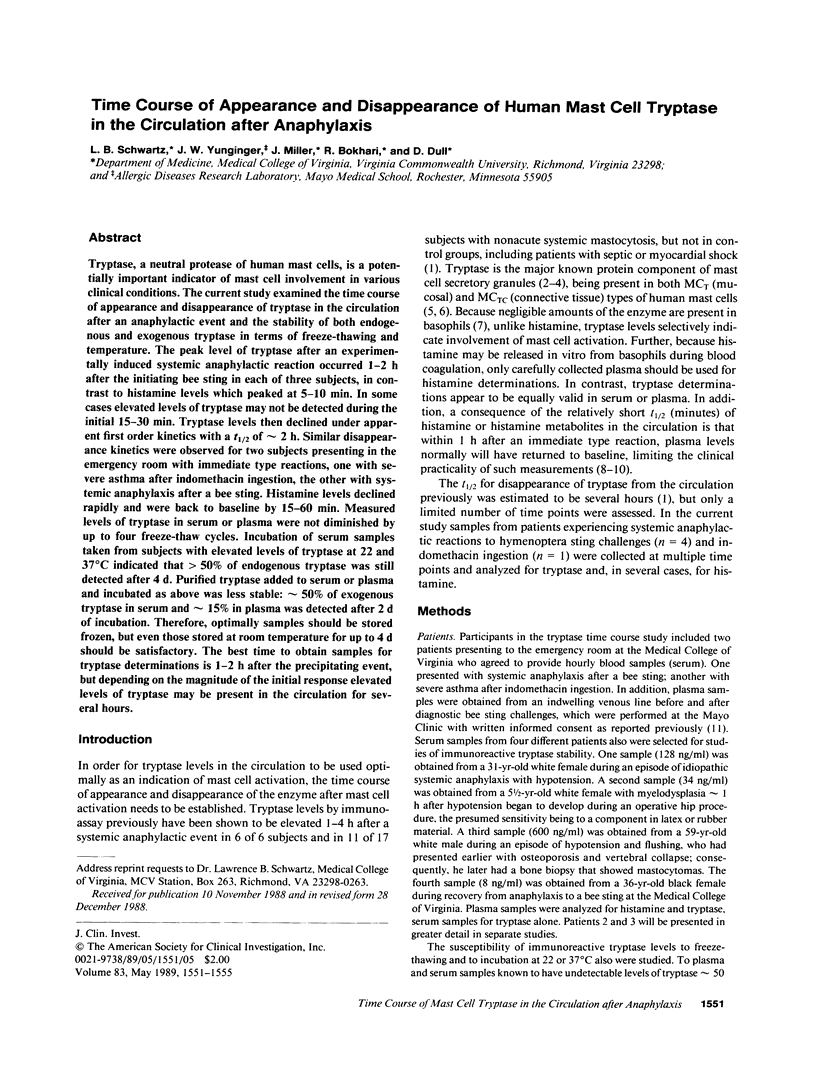
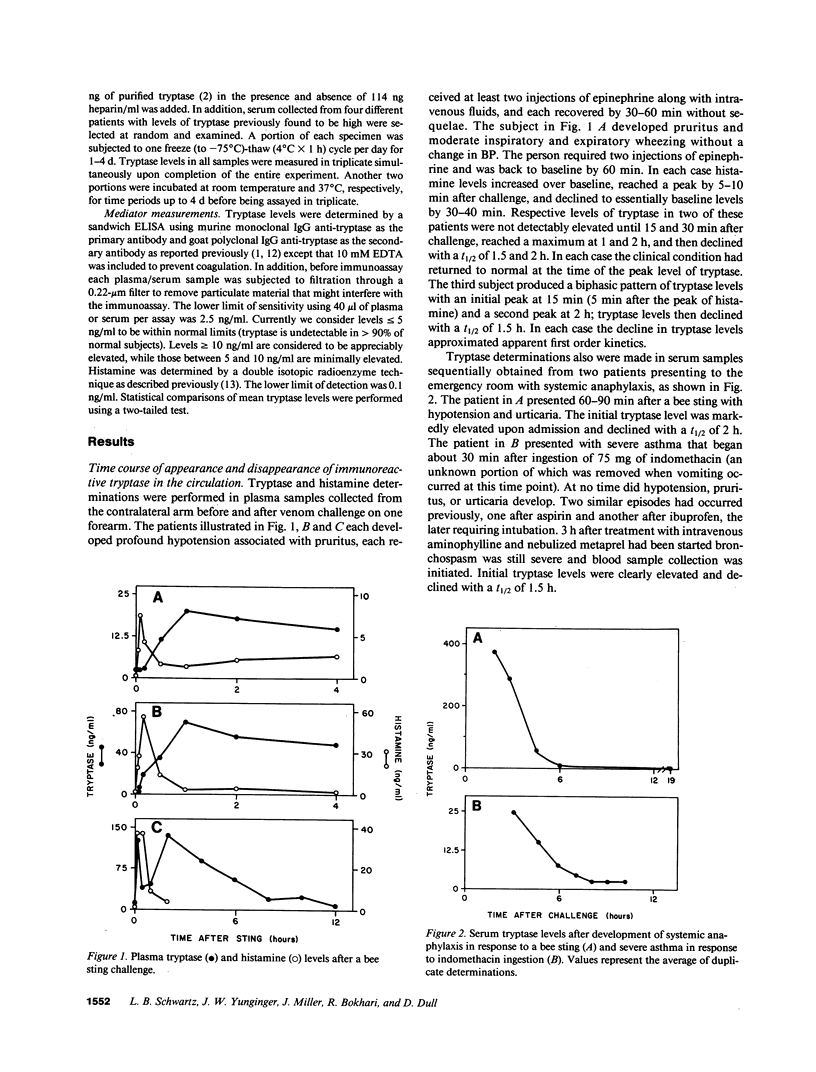
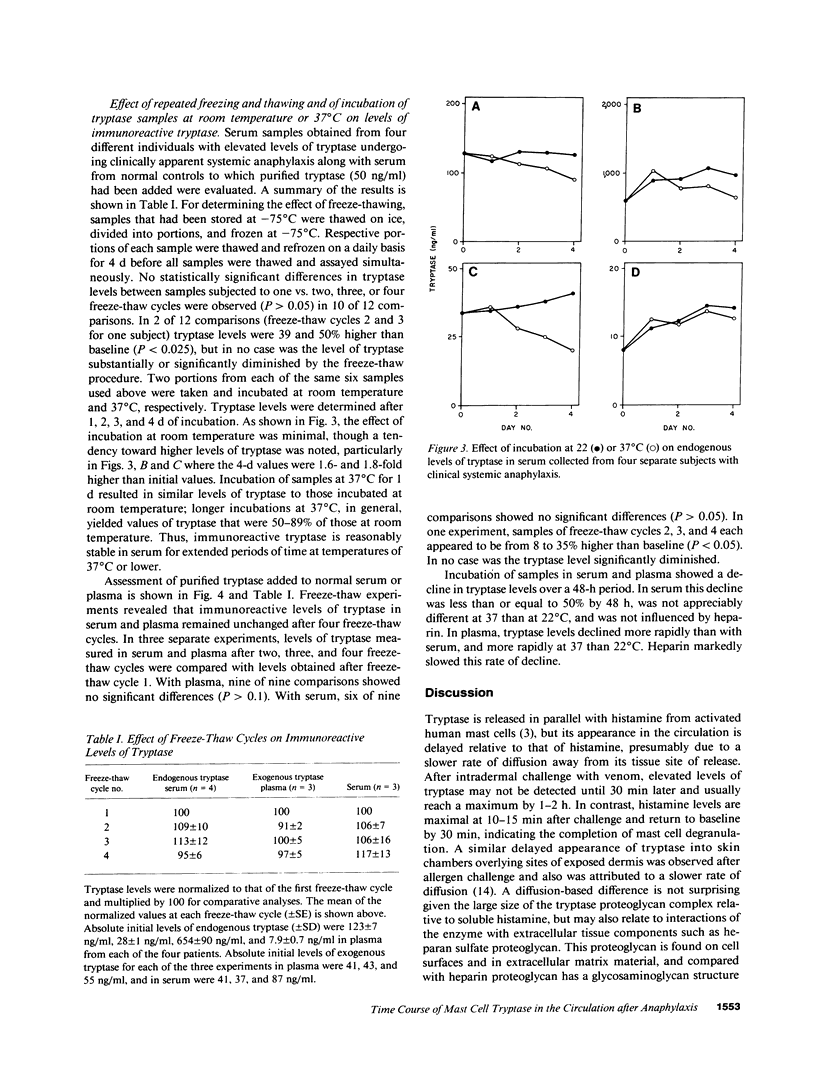
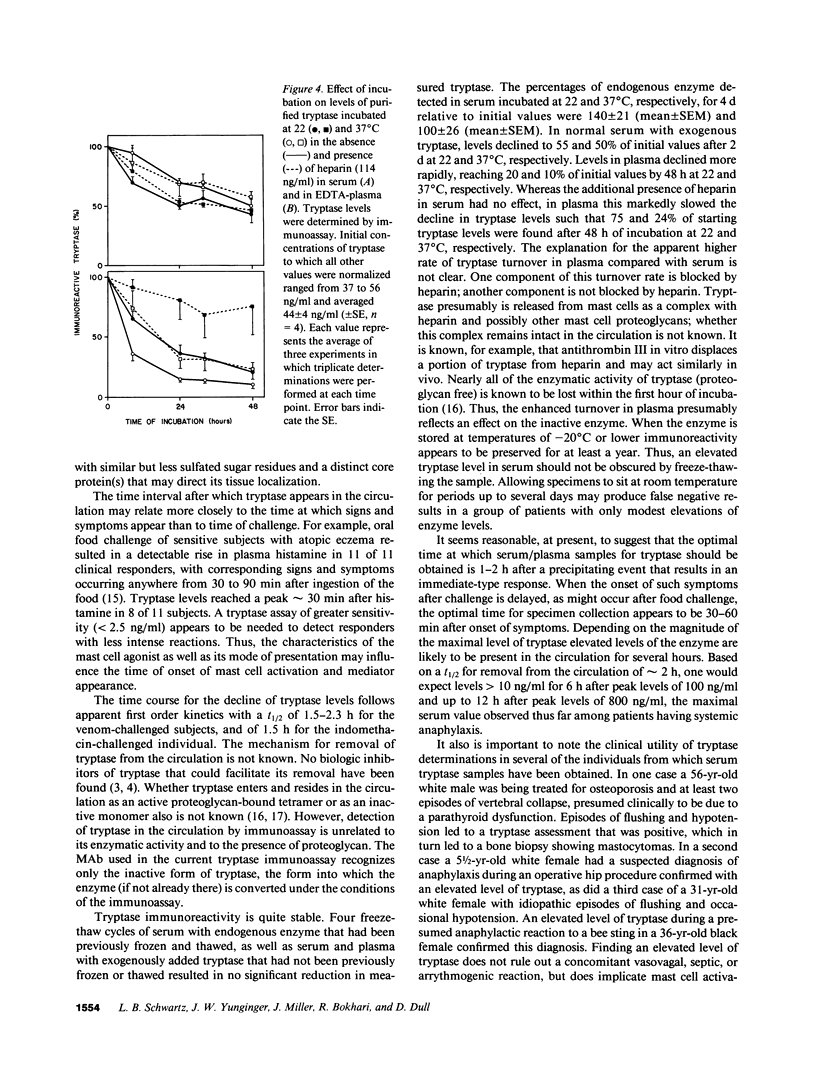
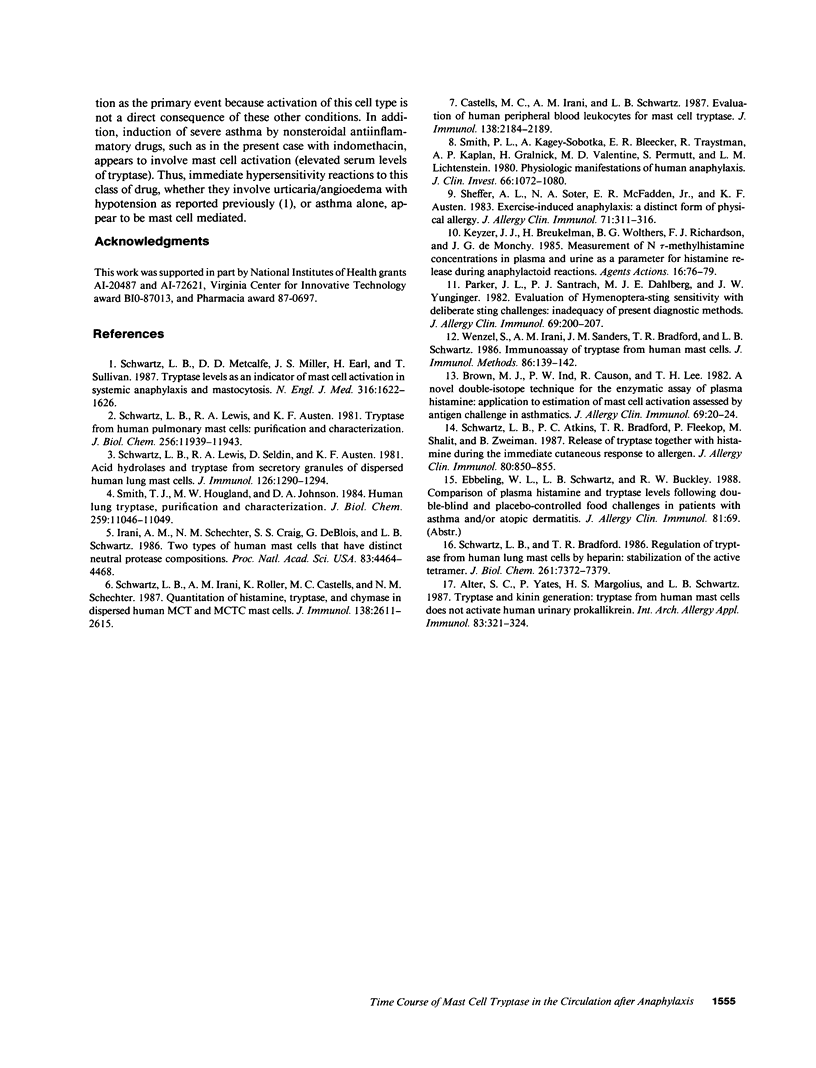
Selected References
These references are in PubMed. This may not be the complete list of references from this article.
- Alter S. C., Yates P., Margolius H. S., Schwartz L. B. Tryptase and kinin generation: tryptase from human mast cells does not activate human urinary prokallikrein. Int Arch Allergy Appl Immunol. 1987;83(3):321–324. doi: 10.1159/000234315. [DOI] [PubMed] [Google Scholar]
- Brown M. J., Ind P. W., Causon R., Lee T. H. A novel double-isotope technique for the enzymatic assay of plasma histamine: application to estimation of mast cell activation assessed by antigen challenge in asthmatics. J Allergy Clin Immunol. 1982 Jan;69(1 Pt 1):20–24. doi: 10.1016/0091-6749(82)90082-3. [DOI] [PubMed] [Google Scholar]
- Castells M. C., Irani A. M., Schwartz L. B. Evaluation of human peripheral blood leukocytes for mast cell tryptase. J Immunol. 1987 Apr 1;138(7):2184–2189. [PubMed] [Google Scholar]
- Irani A. A., Schechter N. M., Craig S. S., DeBlois G., Schwartz L. B. Two types of human mast cells that have distinct neutral protease compositions. Proc Natl Acad Sci U S A. 1986 Jun;83(12):4464–4468. doi: 10.1073/pnas.83.12.4464. [DOI] [PMC free article] [PubMed] [Google Scholar]
- Keyzer J. J., Breukelman H., Wolthers B. G., Richardson F. J., de Monchy J. G. Measurement of N tau-methylhistamine concentrations in plasma and urine as a parameter for histamine release during anaphylactoid reactions. Agents Actions. 1985 Apr;16(3-4):76–79. doi: 10.1007/BF01983105. [DOI] [PubMed] [Google Scholar]
- Parker J. L., Santrach P. J., Dahlberg M. J., Yunginger J. W. Evaluation of Hymenoptera-sting sensitivity with deliberate sting challenges: inadequacy of present diagnostic methods. J Allergy Clin Immunol. 1982 Feb;69(2):200–207. doi: 10.1016/0091-6749(82)90100-2. [DOI] [PubMed] [Google Scholar]
- Schwartz L. B., Atkins P. C., Bradford T. R., Fleekop P., Shalit M., Zweiman B. Release of tryptase together with histamine during the immediate cutaneous response to allergen. J Allergy Clin Immunol. 1987 Dec;80(6):850–855. doi: 10.1016/s0091-6749(87)80276-2. [DOI] [PubMed] [Google Scholar]
- Schwartz L. B., Bradford T. R. Regulation of tryptase from human lung mast cells by heparin. Stabilization of the active tetramer. J Biol Chem. 1986 Jun 5;261(16):7372–7379. [PubMed] [Google Scholar]
- Schwartz L. B., Irani A. M., Roller K., Castells M. C., Schechter N. M. Quantitation of histamine, tryptase, and chymase in dispersed human T and TC mast cells. J Immunol. 1987 Apr 15;138(8):2611–2615. [PubMed] [Google Scholar]
- Schwartz L. B., Lewis R. A., Austen K. F. Tryptase from human pulmonary mast cells. Purification and characterization. J Biol Chem. 1981 Nov 25;256(22):11939–11943. [PubMed] [Google Scholar]
- Schwartz L. B., Lewis R. A., Seldin D., Austen K. F. Acid hydrolases and tryptase from secretory granules of dispersed human lung mast cells. J Immunol. 1981 Apr;126(4):1290–1294. [PubMed] [Google Scholar]
- Schwartz L. B., Metcalfe D. D., Miller J. S., Earl H., Sullivan T. Tryptase levels as an indicator of mast-cell activation in systemic anaphylaxis and mastocytosis. N Engl J Med. 1987 Jun 25;316(26):1622–1626. doi: 10.1056/NEJM198706253162603. [DOI] [PubMed] [Google Scholar]
- Sheffer A. L., Soter N. A., McFadden E. R., Jr, Austen K. F. Exercise-induced anaphylaxis: a distinct form of physical allergy. J Allergy Clin Immunol. 1983 Mar;71(3):311–316. doi: 10.1016/0091-6749(83)90085-4. [DOI] [PubMed] [Google Scholar]
- Smith P. L., Kagey-Sobotka A., Bleecker E. R., Traystman R., Kaplan A. P., Gralnick H., Valentine M. D., Permutt S., Lichtenstein L. M. Physiologic manifestations of human anaphylaxis. J Clin Invest. 1980 Nov;66(5):1072–1080. doi: 10.1172/JCI109936. [DOI] [PMC free article] [PubMed] [Google Scholar]
- Smith T. J., Hougland M. W., Johnson D. A. Human lung tryptase. Purification and characterization. J Biol Chem. 1984 Sep 10;259(17):11046–11051. [PubMed] [Google Scholar]
- Wenzel S., Irani A. M., Sanders J. M., Bradford T. R., Schwartz L. B. Immunoassay of tryptase from human mast cells. J Immunol Methods. 1986 Jan 22;86(1):139–142. doi: 10.1016/0022-1759(86)90277-2. [DOI] [PubMed] [Google Scholar]


